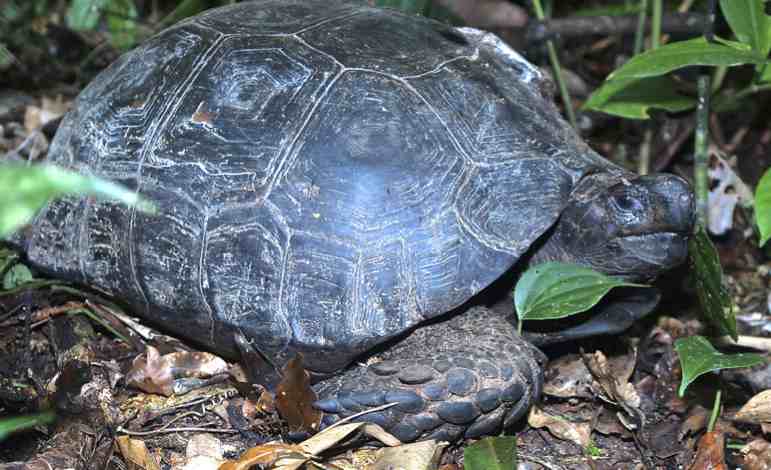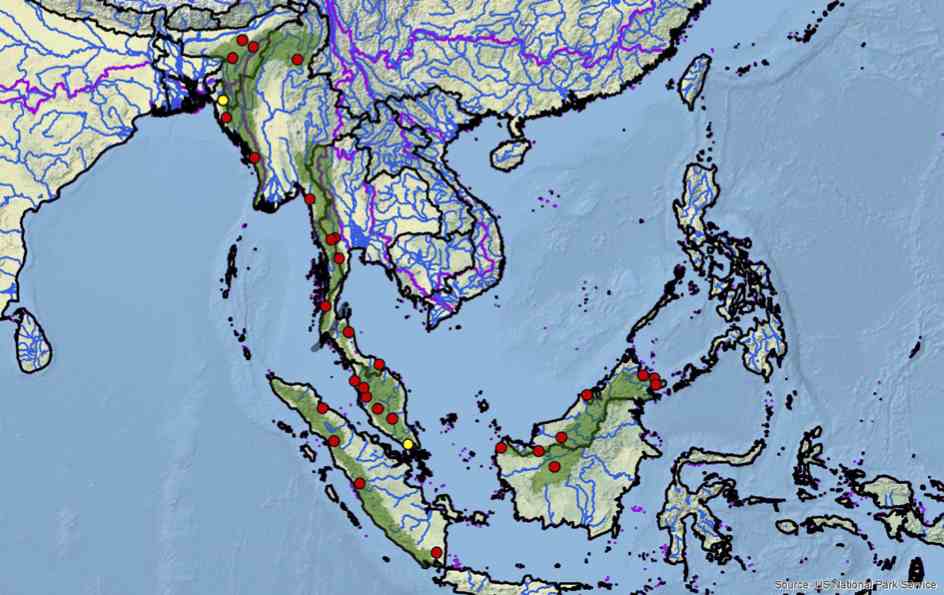Manouria emys, 086
Manouria emys (Schlegel and Müller 1840) –
Asian Giant Tortoise, Giant Asian Forest Tortoise
Craig B. Stanford1, Pratyaporn Wanchai2, Chuck Schaffer3,
Rick Schaffer4, and Kumthorn Thirakhupt2
1Department of Biological Sciences, University of Southern California,
Los Angeles, California 90089 USA [[email protected]];
2Department of Biology, Faculty of Science, Chulalongkorn University,
Bangkok, Thailand [[email protected], [email protected]];
313811 Tortuga Point Drive, Jacksonville, Florida 32225 USA [[email protected]];
4University of Florida, College of Engineering, Gainesville, Florida 32611 USA [[email protected]]
Summary. – The Giant Asian Forest Tortoise, Manouria emys (Family Testudinidae), is the largest tortoise species in mainland Asia, with a straight carapace length (CL) of up to at least 600 mm, and mass up to 37 kg. Two subspecies, M. e. emys and M. e. phayrei, are distinguished by geographic distribution, coloration, plastral scute pattern, and maximum size. Manouria is considered to be among the most primitive of living tortoise genera. The species occurs in hilly wet forest; its diet includes green vegetation, mushrooms, bamboo shoots, and fallen fruits. Unlike most tortoises, which tend to prefer relatively arid habitats, M. emys prefers a mesic habitat and is often found in and around cool flowing streams, sitting for days in water or mud, or foraging in such habitats. Although the species is active all year round, some individuals exhibit an inactive period of up to two months in the cool dry season. The species exhibits unusual nesting activity; females build mound nests of forest floor debris, deposit large annual clutches of up to 60 eggs, and guard the nest for the early portion of incubation. Despite their size, the behavioral ecology of M. emys has been little studied. The species has apparently been extirpated in the westernmost portion of its range and is highly threatened everywhere else. Healthy populations are known to occur in a few protected areas in Thailand and Indonesia, but most remaining habitat is being rapidly degraded and destroyed, and the species continues to be collected for food and smuggled into the pet trade.
Distribution. – Bangladesh, Brunei (?), India, Indonesia, Malaysia, Myanmar, Singapore (extirpated), Thailand. From Assam in India and eastern Bangladesh in the west, through Myanmar and western Thailand, and south through peninsular Malaysia to Sumatra and Borneo in the east.
Synonymy. – Testudo emys Schlegel and Müller 1840, Manouria emys, Manouria emys emys, Geochelone emys, Geochelone emys emys, Testudo emys emys, Testudo emydoides Duméril and Bibron in Duméril and Duméril 1851, Manouria emydoides, Manouria fusca Gray 1854, Teleopus luxatus Le Conte 1854, Manouria luxata, Testudo (Scapia) falconeri Gray 1869 (partim, nomen dubium), Testudo falconeri, Scapia falconeri.
Subspecies. – Currently two recognized: 1) Manouria emys emys (Asian Brown Giant Tortoise) (distribution: Brunei [?], Indonesia, Malaysia, Singapore [extirpated], Thailand), and 2) Manouria emys phayrei (Burmese Black Giant Tortoise, Burmese Mountain Tortoise) (synonymy: Testudo phayrei Blyth 1853, Scapia phayrei, Manouria emys phayrei, Testudo (Scapia) falconeri Gray 1869 (partim, nomen dubium), Testudo falconeri, Scapia falconeri, Testudo nutapundi Reimann in Nutaphand 1979, Geochelone nutapundi, Manouria emys nutapundi, Geochelone emys nutapundi, Manouria nutapundi) (distribution: Bangladesh, India, Myanmar, Thailand).
Status. – IUCN 2014 Red List: Endangered (EN A1cd+2cd; assessed 2000); TFTSG Draft Red List: Critically Endangered (CR, assessed 2011); CITES: Appendix II (as Testudinidae spp.).
Citation:
Stanford, C.B., Wanchai, P., Schaffer, C., Schaffer, R., and Thirakhupt, K. 2015. Manouria emys (Schlegel and Müller 1840) – Asian Giant Tortoise, Giant Asian Forest Tortoise. In: Rhodin, A.G.J., Pritchard, P.C.H., van Dijk, P.P., Saumure, R.A., Buhlmann, K.A., Iverson, J.B., and Mittermeier, R.A. (Eds.). Conservation Biology of Freshwater Turtles and Tortoises: A Compilation Project of the IUCN/SSC Tortoise and Freshwater Turtle Specialist Group. Chelonian Research Monographs 5(8):086.1–9, doi:10.3854/crm.5.086.emys.v1.2015, //iucn-tftsg.org/cbftt/.
(Adobe Acrobat 6.0 or later required)

Manouria emys phayrei in Kaeng Krachan National Park, Thailand.
Photo by Craig Stanford.
Distribution:

Historic distribution of Manouria emys in Southeast Asia. Purple lines = boundaries delimiting major watersheds (level 3 hydrologic unit compartments – HUCs); red dots = museum and literature occurrence records based on Iverson (1992) plus more recent data, and the authors’ personal data; yellow dots = historic observations where populations have likely been extirpated; broad gray line = approximate boundary between the two subspecies, north of the Thailand–Malaysia border, with M. emys phayrei to the north and M. emys emys to the south and east; green shading = projected historic native distribution based on GIS-defined level 10 HUCs constructed around verified localities and then adding HUCs that connect known point localities in the same watershed or physiographic region, and similar habitats and elevations as verified HUCs (Buhlmann et al. 2009; TTWG 2014), and adjusted based on authors’ subsequent data.








